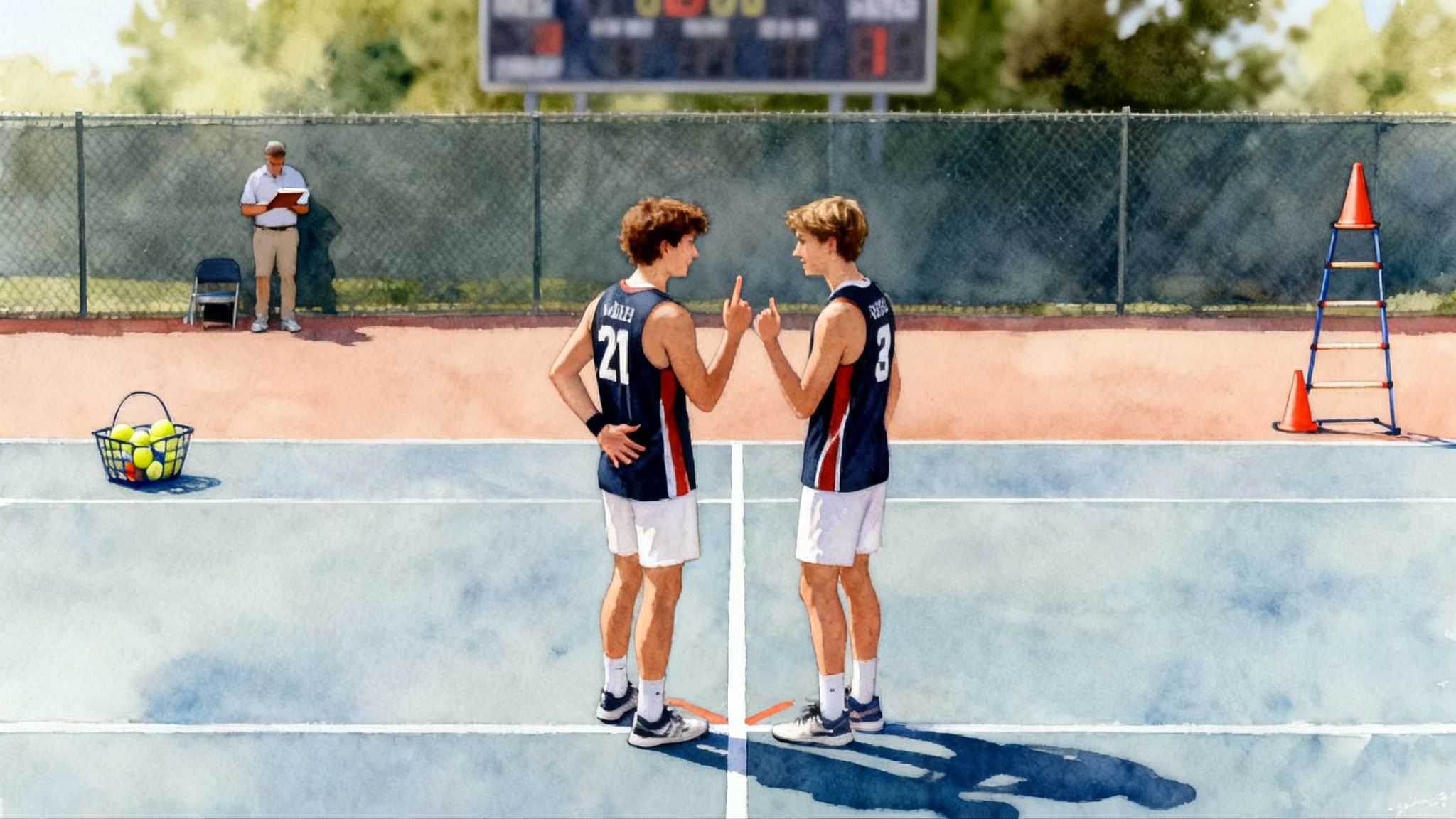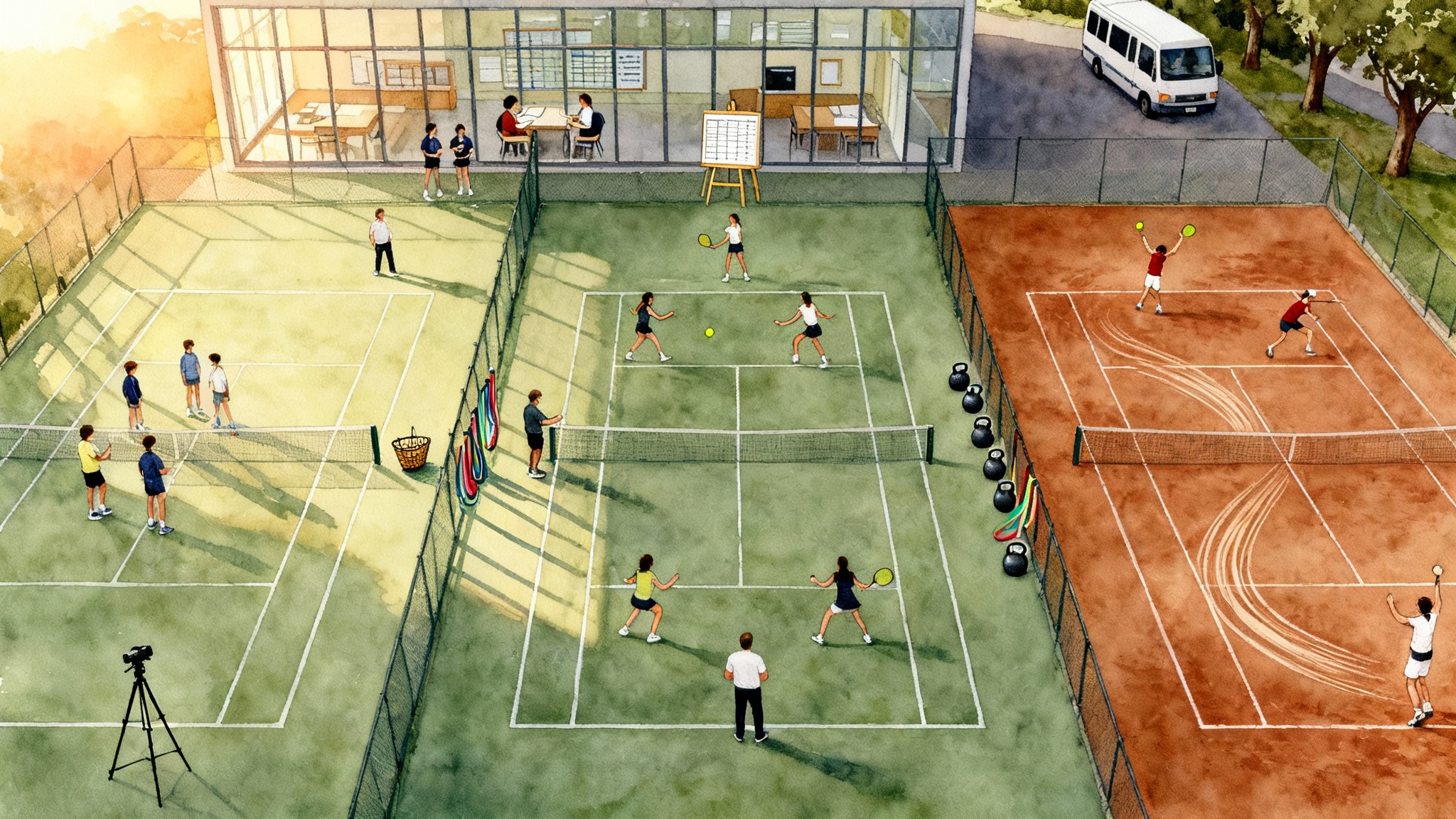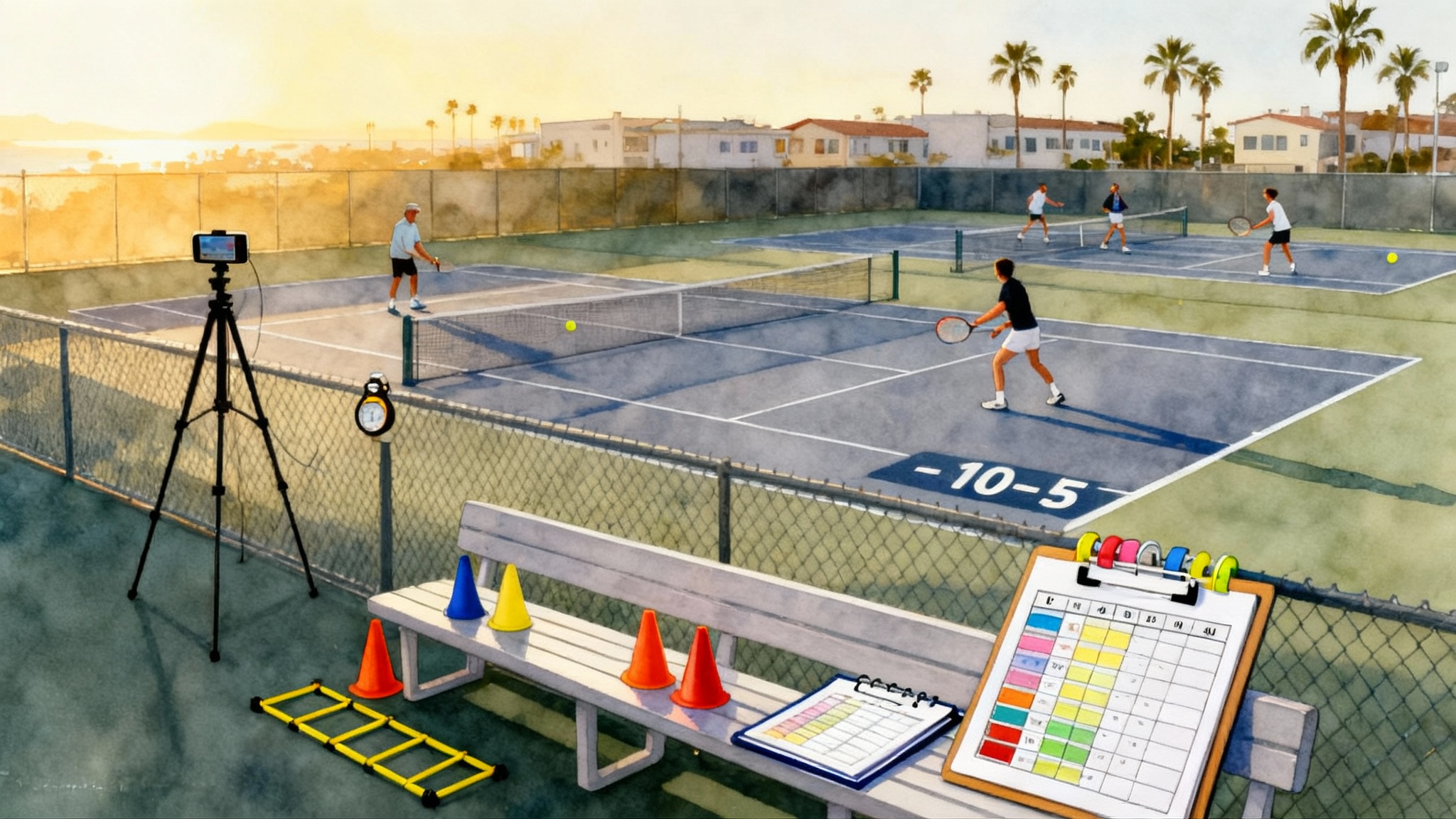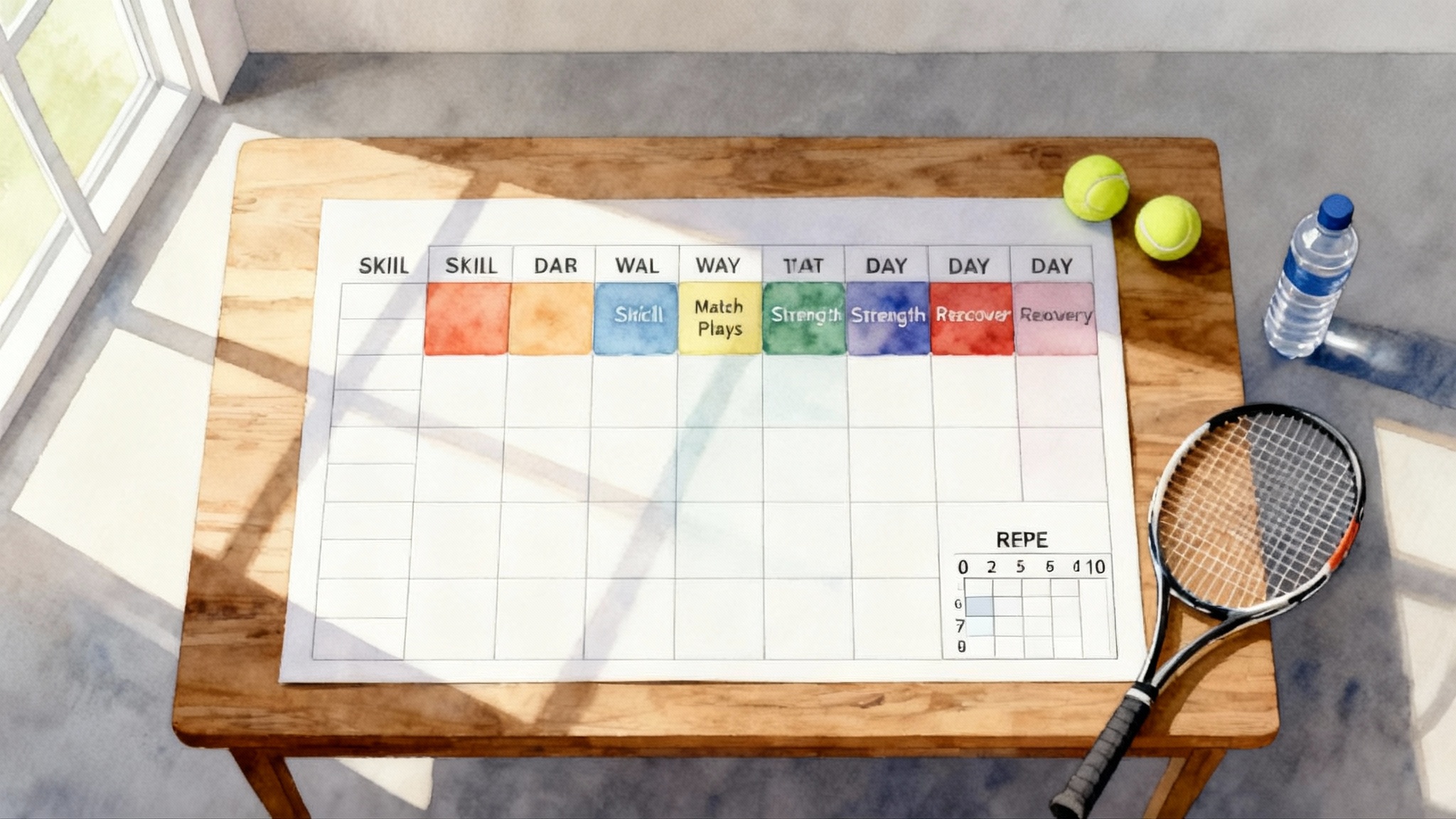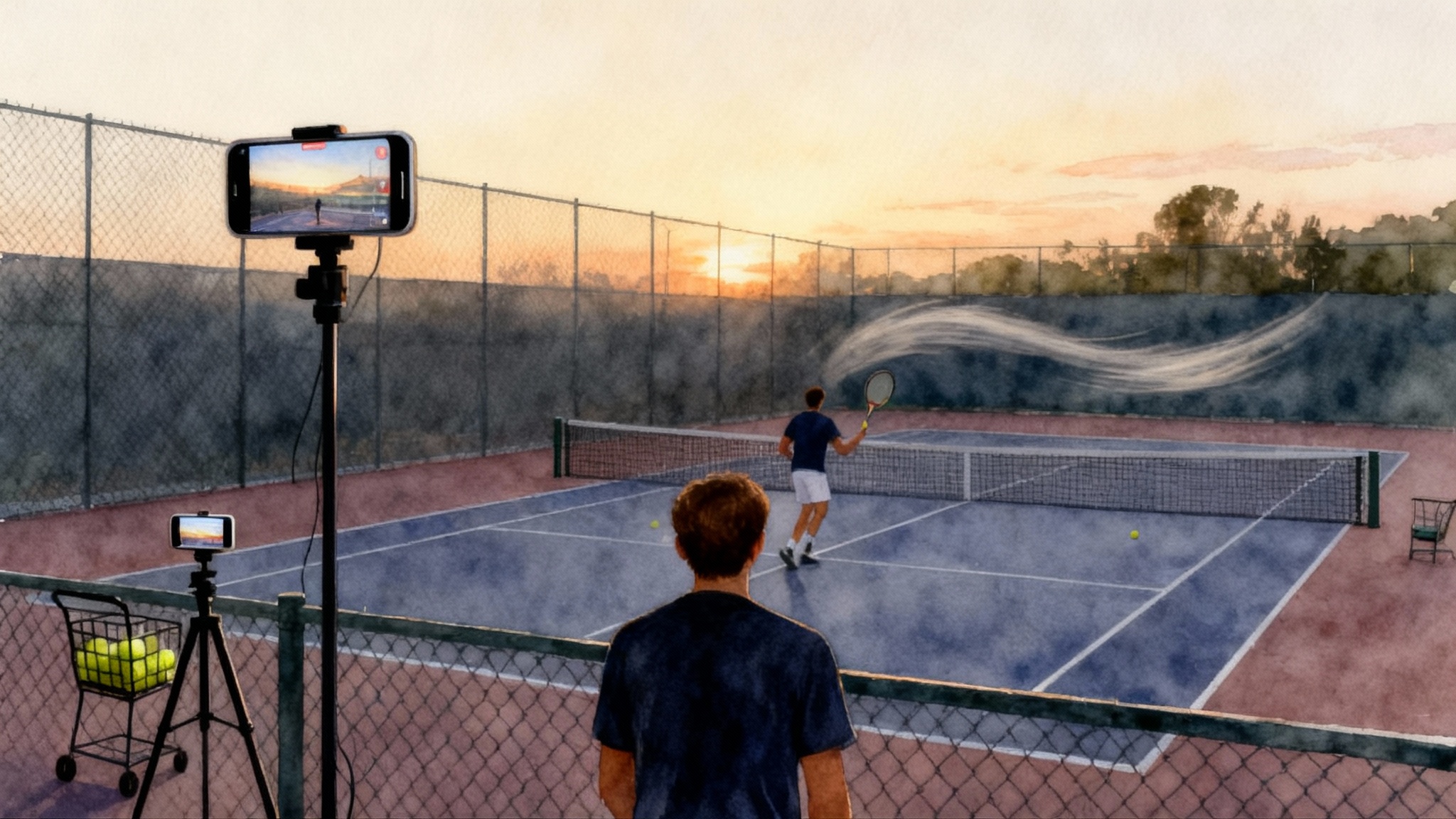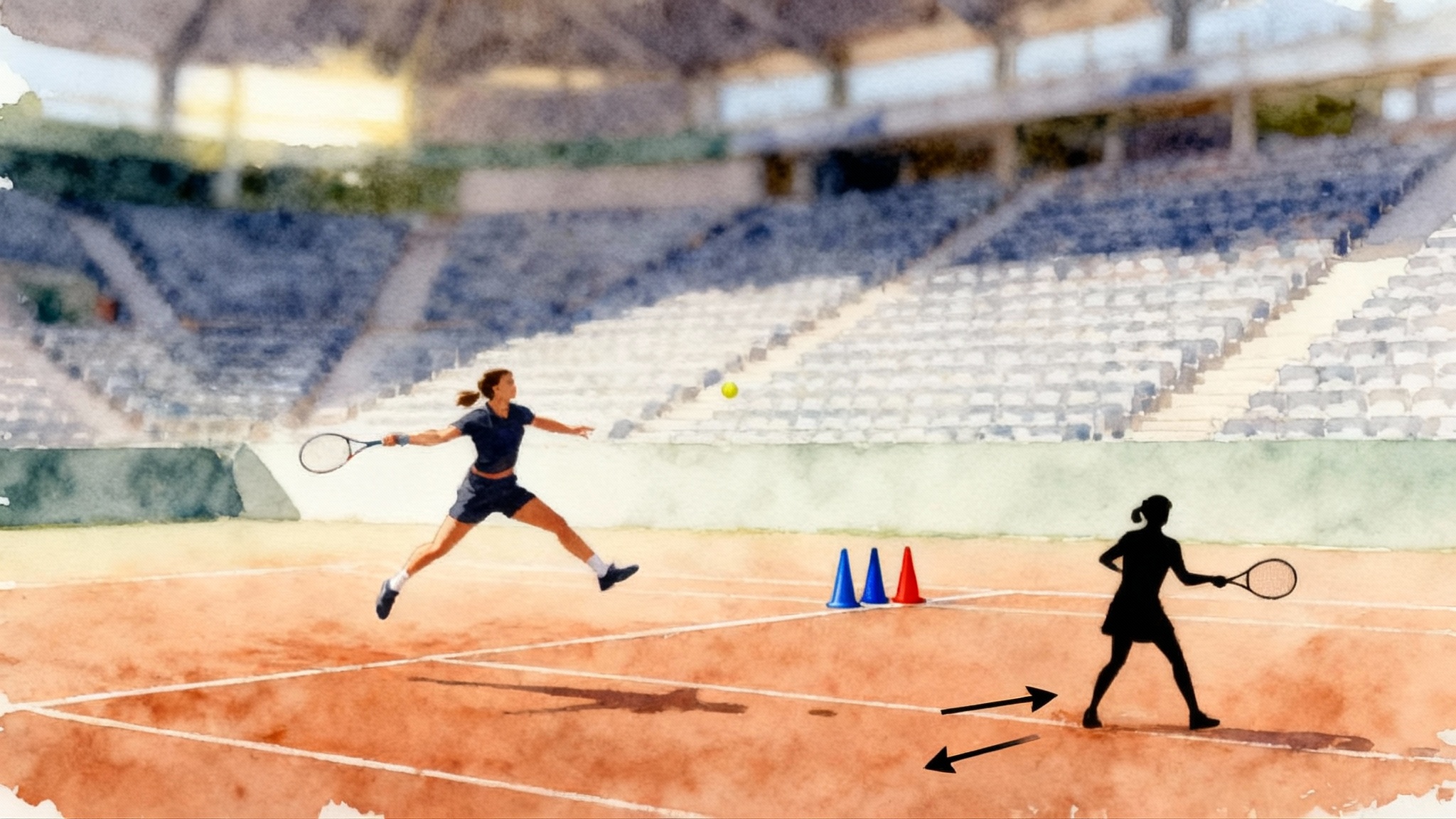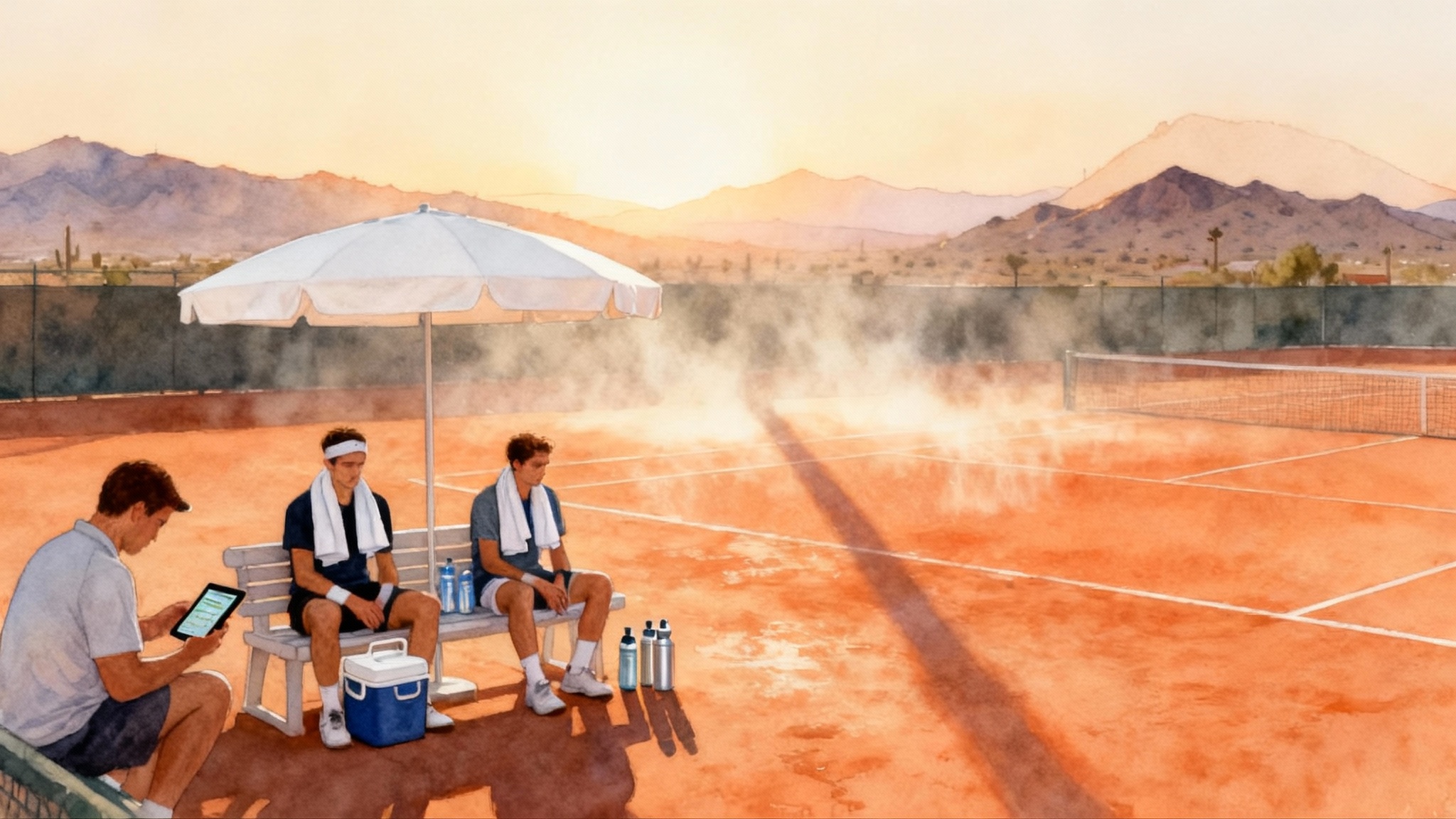Growth-Spurt-Proof Tennis: Prevent Overuse Injuries Ages 11 to 15
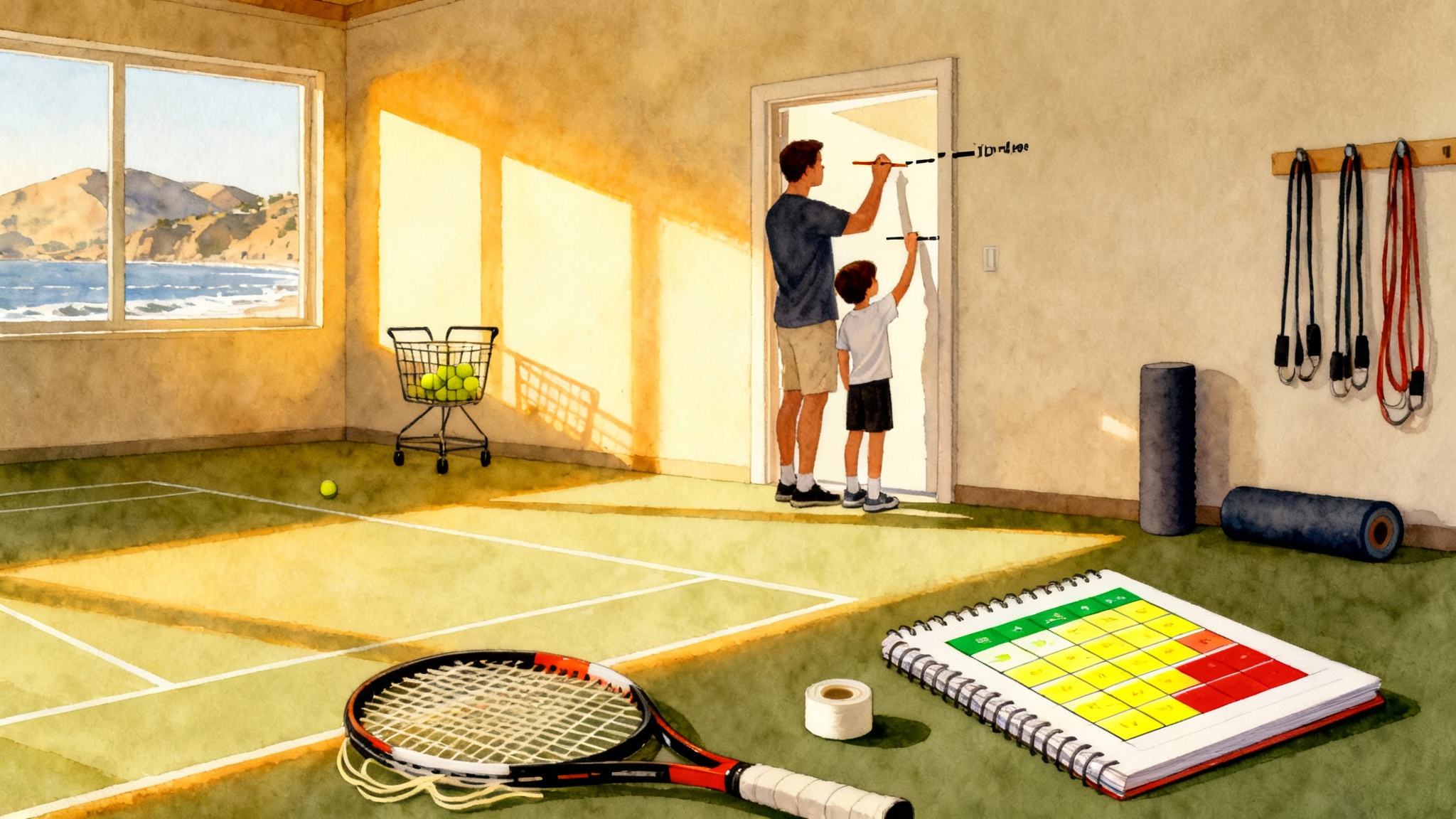
Why growth spurts change tennis risk
Between ages 11 and 15, many juniors hit peak height velocity, the several-month window when a young athlete grows faster than at any other time outside infancy. Bones lengthen first. Muscles, tendons, and the neuromuscular system need time to catch up. That lag changes how force travels through the body. A serve that felt smooth last month can suddenly tug at the front of the knee, the heel, the elbow, or the shoulder. Add tournaments on hard courts and extra lessons, and you have a recipe for overuse issues if you do not plan carefully.
This guide gives you a parent-friendly roadmap that keeps training aligned with growth. You will learn:
- How to tell if your child is entering a rapid-growth window using two-minute home screens
- How to adjust technique and weekly volume based on a simple traffic-light model
- Which isometric and mobility exercises fit 11 to 15 year olds and how to progress them safely
- How to tune racquet weight, string type, tension, and grip size to reduce joint stress
- A full sample microcycle from Santa Cruz High-Performance Tennis Academy that you can adapt to your week
Nothing here replaces medical care. If pain lingers or worsens, see a qualified clinician. Think of this as the coordinator’s manual that helps you, your child, and the coach stay on the same page.
A two-minute, at-home PHV check
You do not need a lab to spot peak height velocity. Build these quick checks into your week. Do them on the same weekday, in the morning before breakfast.
- Height diary on a doorframe
- Tools: pencil, tape measure, socks off, heels and upper back touching the wall
- Action: mark height once per week, then measure to the nearest millimeter or one eighth of an inch
- What to watch: a sustained rise of more than 1.5 to 2 centimeters over a month suggests a growth surge. A single big jump is less important than a steep slope over several weeks
- Coordination and balance snapshot
- Single-leg balance: stand on one leg, hands on hips, eyes open for 20 seconds. Count foot touches or wobbles. More than five wobbles per side or a sudden drop versus last week hints at neuromuscular lag
- Skipping rhythm: 20 meters of easy skipping. If timing looks clumsy or the rope catches more than usual, note it. The brain is recalibrating limb length
- Lower-body mobility spot checks
- Knee-to-wall ankle test: kneel facing a wall, foot flat, big toe 10 centimeters from the wall. Can the knee touch the wall without the heel lifting? If not, ankle mobility may be tight, which increases stress up the chain
- Hip rotation check: sit tall in 90-90 hip position. If one side feels blocked or shaky, mark it
- The 24-hour response rule
- After a normal practice, there should be no next-day limp, swelling, or pain that changes how your child moves. If the 24-hour response gets worse across a week, scale back
Put these results in a simple note on your phone. You are not diagnosing. You are tracking trends that guide training decisions.
The traffic-light model for training during growth
Use a traffic-light model to align practice, strength, and tournaments with growth status.
- Green zone: no rapid change in height diary, balance is steady, and the 24-hour response is normal. Train normally with smart strength and movement quality work
- Yellow zone: height rising quickly, balance and rhythm dip, or the 24-hour response shows more stiffness than usual. Keep frequency, trim volume, and reduce speed peaks
- Red zone: height surging plus pain in common hot spots like the heel, front of the knee, or elbow, or next-day pain that alters movement. Protect tissues by lowering weekly balls struck, limiting max-serve loads, and pausing tournaments for two to four weeks while you rebuild tolerance
This is not about doing less forever. It is about timing the right work at the right moment. Think of development as waves. In the yellow and red zones you ride the wave with technique, mobility, and controlled strength. When the water settles, you add speed and volume again.
Tournament load that respects recovery
During growth, match stress and hard-court volume count more than ever. For 11 to 15 year olds, keep two principles in mind:
- One full day off per week from organized sport. That is a day without match play, lessons, or strength training
- A simple guardrail: total weekly hours of organized sport should not exceed the child’s age. A 13 year old should generally live near 13 total hours across practices, matches, and fitness. If school tennis adds hours, adjust club time
When a growth surge is active, be even stricter. Enter fewer back-to-back tournament weekends. If you do compete, prefer draws with smaller match counts or flexible scheduling so you can scratch a late match without penalty if pain shows up. To pick events without burnout, see the breakdown in UTR vs WTN vs NTRP in 2025.
Technique priorities that match each zone
You can keep improving skills in every zone. The trick is picking the right emphasis.
Green zone
- Serving: reinforce a soft landing under the lead foot and a clean, high elbow on the trophy position. Use a simple cue like “lift, reach, snap” with three shadow swings for every live serve
- Groundstrokes: raise consistency and shape by rallying to deep crosscourt targets with steady tempo. Track balls in play per rally, not winners
- Footwork: short acceleration and deceleration with perfect posture. Ten meter shuttles are enough. For stop mechanics, review the cues in our faster stops and safer knees guide
Yellow zone
- Serving: cut high-effort serves in half. Focus on ball toss, rhythm, and spin serves rather than flat pace
- Groundstrokes: use lower compression balls for some drills to reduce joint stress while refining spacing and topspin brush
- Footwork: replace most high-speed chases with split-step timing drills and lateral shuffle quality
Red zone
- Serving: shadow sequences and medicine-ball wall throws at submax speed, 3 kilograms or less. Keep reps low and crisp
- Groundstrokes: ball machine or cooperative feeds that target clean contact at 70 percent pace. Emphasize slice backhand and volley touch to broaden the skill set without pounding joints
- Footwork: movement patterns without maximum pivots. Think dots, ladders, and soft shadow steps
Strength that fits 11 to 15 year olds
Isometrics are your friend during growth. They build tendon capacity, reduce pain sensitivity, and teach joint positions without the joint shear that comes from heavy, fast lifts. Use these as the backbone, then layer in simple tempo work when the green zone returns.
Dosage rules of thumb
- Holds: 20 to 30 seconds for 11 to 12 year olds, 30 to 45 seconds for 13 to 15 year olds
- Sets: 3 to 5 sets, 45 to 60 seconds rest between sets
- Frequency: 3 to 4 days per week in yellow or red zones; 2 to 3 in green
Lower body
- Calf raise isometric: stand on a step, rise to mid-range, and hold tall. Add a backpack for load. Great for Achilles and plantar support
- Spanish squat hold: loop a thick strap behind the knees and around a solid post, sit into a chair position, and hold. Targets patellar tendon and quadriceps with minimal joint shear
- Copenhagen side plank: bottom knee on the ground, top knee on a bench, hold side plank. Start with 10 to 20 second holds, build to 30 to 40. Supports groin and change of direction
Hips and trunk
- Wall sit with adduction: place a ball or pillow between knees and squeeze during a wall sit. Two birds with one stone: quads and adductors
- Dead bug isometric: press opposite hand and knee together while keeping ribs down. Ten breaths per side, two to three rounds
Shoulder and elbow
- External rotation hold: stand with elbow at 90 degrees by the side, forearm across the belly. Press the back of the hand gently into a doorframe, hold without shrugging
- Scapular retraction hold: loop a light band around a post and pull shoulder blades together, elbows locked at a soft bend. Hold, breathe, and keep the neck relaxed
- Wrist extensor hold: light dumbbell or hammer, elbow on thigh, wrist neutral. Resist flexing downward for 20 to 30 seconds
Progression
- Start with bodyweight or very light load
- Add small load when holds feel steady and next-day response is normal
- When the green zone returns, layer in slow tempo squats, split squats, and hinge patterns with two to three seconds down, one second pause, and two seconds up. Keep reps smooth, never to technical failure
Mobility that sticks
Mobility should not look like a stretching marathon. Ten to fifteen focused minutes are plenty if you repeat them most days.
Daily sequence
- Ankles: half-kneeling knee-to-wall, 10 slow reps per side. Keep the heel down
- Hips: 90-90 transitions, five to eight slow reps per side. Move only in the range you can control
- Hip flexors: half-kneeling hip flexor stretch with glute squeeze, three sets of 20 to 30 seconds per side
- Thoracic spine: open-book rotations on the floor, eight reps per side
- Forearm care: slow wrist flexor and extensor stretches, two sets of 20 seconds each after play
Rule of one change
- Pick one spot that limits your child most and give it extra attention for two weeks. Expect small, steady improvements, not overnight miracles
Equipment tweaks that save joints
Racquet length and weight
- Match racquet length to height and control. If a player is new to a taller frame after a growth spurt, resist the urge to jump to extra-long or very head-heavy models right away. A slightly lighter, more head-light racquet improves maneuverability during a clumsy phase
String type and tension
- Softer strings like multifilament or natural gut decrease impact shock compared with full polyester setups. If your junior already uses polyester, consider a hybrid with multifilament in the crosses, and drop tension by 10 percent during growth surges to soften impact
Grip size and handle feel
- Check grip size every six months. A simple method is to measure from the middle palm crease to the tip of the ring finger in inches. That number approximates grip size. Too small a grip can increase forearm strain, too large can limit wrist mobility
- A basic vibration dampener reduces string ping but does not change frame vibration much. The bigger effect on comfort is softer strings and lower tension
Balance tuning
- Adding a small amount of lead tape under the grip shifts balance toward head light, which many juniors find easier on the arm. Make small changes and test for a week before adding more
Shoes
- Replace tennis shoes when the outsole is worn smooth or after 45 to 60 hours of hard-court play. Fresh cushioning and heel support matter during growth, especially for heel pain
The Santa Cruz High-Performance Tennis Academy microcycle
Below is a sample week the Santa Cruz High-Performance Tennis Academy uses with 11 to 15 year olds. It assumes a yellow-zone growth period for a 13 year old who practices four days, plays a weekend match, and attends school. Adjust volumes for your context.
Daily anchors
- Morning: two-minute PHV check and note yesterday’s 24-hour response
- Warm up: five minutes of easy jog or skip, then the daily mobility sequence
- Cool down: three minutes of nasal breathing walk plus forearm care
Monday
- Court: 75 minutes. Technical focus on groundstroke spacing and crosscourt consistency at 70 percent pace. Serve rhythm with spin only, 30 total serves
- Strength: 20 minutes. Calf raise isometric 4 x 30 seconds, Spanish squat hold 4 x 30 seconds, scapular retraction hold 3 x 30 seconds, dead bug 3 x 8 breaths
- Homework: five minutes of 90-90 hip transitions and ankle knee-to-wall
Tuesday
- Court: 60 minutes. Volley touch and approach patterns. Cooperative doubles drills, no point play
- Conditioning: 12 minutes. Three sets of 10 meter shuttles, two accelerations and two decelerations per set, perfect posture. Rest one minute per set
- Strength: Copenhagen side plank 3 x 20 seconds per side, external rotation hold 3 x 30 seconds per side, wrist extensor hold 3 x 20 seconds per side
Wednesday
- Court: 75 minutes. Pattern play with targets and low-compression balls for half the session to reduce joint load. Limited point play, first to four with no-ad scoring. Serving capped at 40 total with a focus on toss and spin
- Mobility: 15 minutes. Hip flexor holds, thoracic open-book, forearm stretches
- Optional: short video review of serve and forehand. Cue two fixes only
Thursday
- Court: Off
- Strength and movement: 25 minutes. Wall sit with adduction 4 x 30 seconds, slow tempo split squat 3 x 6 per side, dead bug 3 x 8 breaths, ankle knee-to-wall 10 reps per side
- Recovery habit: eight to nine hours of sleep, a protein and fruit snack after practice days
Friday
- Court: 60 minutes. Serve plus one pattern at 70 percent pace. Doubles formations walk-through. Keep the tank at three quarters full going into the weekend
- Strength: Light primer. Calf raise isometric 3 x 20 seconds, external rotation hold 2 x 20 seconds, forearm care
Saturday
- Match day: One singles match. Full warm up. If the 24-hour response has been trending stiff, scratch a second match or play only doubles. Between sets, sip water, and do two ankle and two hip mobility drills
- Evening: Ten-minute walk, nasal breathing, gentle forearm stretches
Sunday
- Off from organized sport. Family activity like a hike or easy bike ride is fine if it feels refreshing
Tournament-week modifications
- If a weekend tournament has two singles matches per day, cut weekday court time by 25 to 40 percent and do only two strength sessions, Monday and Thursday. Keep isometrics on Friday as a primer
Green-zone version
- Bring total serves per practice up by 20 to 30 percent across two weeks, return to full-pressure point play midweek, and add one speed session with resisted or assisted sprints, six to eight efforts of 10 meters with full rest
For weekly structures you can reuse year-round, pair this plan with the scheduling ideas in UTR vs WTN vs NTRP in 2025 and the stop-start mechanics in our faster stops and safer knees guide.
How to collaborate with your coach
Share three things weekly:
- The height diary and any yellow or red flags from your at-home checks
- A simple readiness note from your child: better, same, or worse than yesterday
- The plan for serves, point play, and strength blocks, in writing. Ask the coach which two technical cues will get the most value this week and agree on a limit for total high-effort serves
When everyone sees the same numbers and agrees on volume caps, decisions get easier and emotions run lower on match day.
Troubleshooting common hot spots
Heel pain that feels worse after practice
- Likely scenario: growth-related irritation at the heel
- What to do: reduce hard-court time for two weeks, increase calf isometrics, add short heel-raise holds in warm ups, and check shoe cushioning. Avoid back-to-back tournament days
Front-of-knee pain when landing from serves or during deceleration
- Likely scenario: patellar tendon irritation or traction at the shin
- What to do: use Spanish squat holds, cut high-effort serves by half for two weeks, and repeat the 24-hour response check. If next-day pain persists, see a clinician
Elbow pain during backhands or serves
- Likely scenario: forearm extensor overload with stiff strings or too small a grip
- What to do: swap to softer strings or a hybrid, lower string tension by 10 percent, check grip size, and add wrist extensor isometrics. Reduce off-center contact with slower, clean feeding drills
Shoulder tightness
- Likely scenario: rotator cuff and scapular control lagging behind limb length
- What to do: external rotation holds, scapular retraction, and serve-shadow rhythm. Keep the arm path smooth and the landing soft
Shin or hip aching after sprints
- Likely scenario: ankle or hip mobility limits shifting stress to the shin
- What to do: knee-to-wall ankle work, 90-90 hip rotations, and a short break from maximum decelerations
Putting it all together
The most important idea is that growth does not stop development. It changes the order of operations. During the surge, prioritize position, rhythm, and tissue capacity. When the surge settles, turn the dial back toward speed and volume. Use your doorframe, your note app, and a handful of well-chosen drills to steer the week. The result is a junior who arrives at high school and college tennis not just skilled, but durable. That is how you make tennis growth-spurt-proof.
